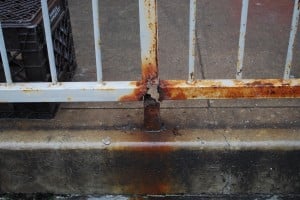If you look around, you’ll see it everywhere. Steel handrail and spindles, wrought iron rail and spindles, tubular handrail mounted to block walls along stairways, and various other forms of metal safety railing are everywhere a fall could take place.
it everywhere. Steel handrail and spindles, wrought iron rail and spindles, tubular handrail mounted to block walls along stairways, and various other forms of metal safety railing are everywhere a fall could take place.
If you pay attention, you’ll see that a majority of this steel is mounted in concrete, and the metal around the intrusion points is rusting. This happens for a few reasons. First, most often the posts are grouted incorrectly, if at all. Epoxy grouts should be used to secure the posts in place and keep water from wicking to the steel.
Very frequently, when contractors mount these railings, they use mortar or cementious materials to do this grouting instead of epoxy. This corner is cut so frequently due to the high cost of epoxies in comparison to cement, along with the comparative ease of use. The result of this action is inevitably rust. As the posts move in their mounting holes, the abrasive cementious material scratches the protective coating on the steel, allowing the moisture that wicks through concrete to react with the the exposed ferrous metal and rust is created.
In northern climates, this effect is magnified by the fact that salt is commonly thown on walkways to treat snow and ice, greatly expediting the formation of rust. Once this process begins, it is a short matter of time before the thin metal used in most manufactured handrail rusts through, creating the need for this expensive handrail to be replaced.
So, what do you do once you realize your handrails are rusting?
If caught early enough, most handrail can be saved. If there are holes in the metal, new steel can be welded in to repair the bad areas. Hopefully, if caught in time, this expensive step may be skipped.
To repaint rusted steel, proper surface preparation is every bit as important as choosing the correct coating system. I’ve read tricks written by others, ranging from wiping with vinegar to chemical treating the rust to wire brushing the heaviest corrosion away and then painting over. All of these will result in the quick return of the same rust you’re fighting to get rid of. To fully remove rust, along with loosely adhering paint caused by the rust, the best, most thorough method is to sandblast the rusted surface.
Immediately following the sandblast, the bare steel should be primed with a high volume solids rust inhibitive alkyd metal primer. In humid climates, flash rust begins almost immediately on bare steel, so it it essential to not waste any time. Following the priming step, you can coat steel with either a rust inhibitive alkyd topcoat, or you can upgrade to an epoxy/urethane system – which despite being substantially more work and significantly more expensive, certainly pays for itself in time by increasing the durabilty and longevity of the coatings.
Finally, after proper surface prep and application of a high quality rust inhibitive protective coating system, we return to the grout step. If there is a gap left around the base of the posts, properly grouting the posts with an epoxy grout material will go a long way towards keeping this process from needing repeating any sooner than absolutely necessary. If cement has already been used to grout the posts, a good concrete sealer will help to keep water from penetrating the surface and hastening the process of corrosion.
If you're in the Greater Pittsburgh Area, and you have rusted handrails, lightposts, I-Beams, or for that matter any rusted ferrous metal surfaces that you would like to have addressed, the experts at ImageWorks Painting would love to discuss your project with you. ImageWorks can handle all aspects of the job from sandblasting, welding, and specialized coatings to concrete repairs around the substrate if necessary.









